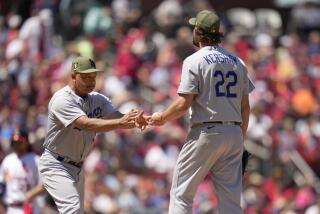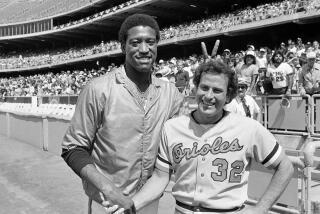These Indians Are All Warm and Fuzzy
- Share via
BALTIMORE — The chill in the Cleveland Indians’ clubhouse went beyond Albert Belle’s insistence that it be that way, and his periodic demolishing of the thermostat to prevent teammates from raising the temperature.
That contributed to a frosty dressing room, of course, but the icy demeanor that enveloped the team seemed to stem from Belle’s belligerence, the often surly Kenny Lofton and the noncommunicative Eddie Murray. The sign on the clubhouse door should have warned, “Reporters, Enter At Your Own Risk.”
The powerhouse Indians of 1995 and ’96 intimidated people on and off the field.
Belle, Lofton and Murray are gone now and the Indians are a different team--in personnel and personality.
They’re media friendly, if you will. Professional, but more apt to whistle while they work.
“When you look at the people we brought in, we knew we had a chance to win again,” shortstop Omar Vizquel said of David Justice, Marquis Grissom and Matt Williams.
“They were successful players with postseason experience, so the numbers are pretty much the same. But personality-wise we’re also a little better. The media isn’t focused on troubled players or what Albert did or didn’t do.”
The Indians have won three consecutive Central Division titles. They did it twice with Belle and Co. And they did it with the new faces of ’97.
Asked to compare the character of the two teams, Manager Mike Hargrove said, “Did you say character or characters?”
He laughed. Apples and oranges, he called it. Both groups won a lot of games, beat up on a lot of people.
“The ’95 and ’96 groups weren’t as media friendly,” he said. “But they weren’t as rowdy and uncontrollable as people were led to believe. This team doesn’t have the same swagger and arrogance, but it’s just as confident.
“I’ve really enjoyed this club, and I’d have to admit that there’s just a better feeling in the clubhouse among the players.”
The Indians eliminated the New York Yankees and now meet the Baltimore Orioles for the American League title. Imagine, they lose a bomber in Belle and a catalyst in Lofton and are still playing for a pennant.
And they are still powerful offensively, General Manager John Hart said, but better defensively, with the financial future having been stabilized.
“Albert Belle legitimized our lineup, but we weren’t going to set a new market, we weren’t going to pay him $11 million,” Hart said.
“We could have afforded to do it, but we sent a message to baseball, to our players and to our fans.
“Were the off-the-field distractions a factor? Absolutely. If there had been fewer distractions, might we have reacted differently? Absolutely.”
Belle left as a free agent last winter. Justice and Grissom were acquired from Atlanta for Lofton in March.
“We made a legitimate [contract] offer to Kenny that he rejected,” Hart said. “We didn’t think we were going to be able to sign him [at the end of the season]. We acquired two productive and experienced players in the prime of their careers for a player that wasn’t going to be back. [Lofton is eligible for free agency.] I think it was pretty shrewd.”
Having already made the multi-player trade with San Francisco for third baseman Williams as the first step in replacing Belle’s offense, and improving the defense by moving Jim Thome from third to first, Hart rebuilt the Indians the old fashioned way--with two blockbuster trades.
“We did what we had to do insofar as making deals to give us comparable players, but my one regret was not being able to acquire a front-line starting pitcher last winter,” he said.
“With a limited market, we targeted [Roger] Clemens, [John] Smoltz and [Alex] Fernandez but weren’t able to sign any of them. If you ask me, that was the only thing separating this club from being even better than the clubs that had Belle and Lofton.
“I mean, people forget that we had the league’s best earned-run average in ’95 and ’96. Of course, we couldn’t have anticipated the number of pitching injuries we had this year.”
The Indians put eight pitchers on the disabled list. Ace Jack McDowell went down for the season in May. Deadline acquisition John Smiley was lost in September.
There are sweet rewards in Cleveland now. Williams will soon be signed to a multiyear contract. Justice and Grissom already have been, as have most of the team’s best players.
The Indians pioneered the art of wrapping up their nucleus and staying ahead of the market. Four years of Jacobs Field sellouts have permitted the Indians to sustain baseball’s third-highest payroll, a long way from the $8 million when Hart took over in 1991. And the payroll is likely to climb in ’98 as they weigh acquisition of a No. 1 pitcher and pursuit of second baseman Chuck Knoblauch, who wants out of Minnesota and has targeted the Indians.
“You can’t have an all-star at every position,” Hart said. “We don’t have an unlimited budget.”
What the Indians do have, however, are a new demeanor and a new degree of what newcomer Bip Roberts described as intensity, toughness and character.
“The Indians have all the ingredients now, and Justice, Grissom and Williams helped bring it together,” said Roberts, whose August acquisition provided a leadoff spark in Lofton’s absence.
Added Hart: “Both Grover [Hargrove] and I have had more fun with this team than any of our others.”
Fun? The Indians? The chill is gone, indeed.
More to Read
Go beyond the scoreboard
Get the latest on L.A.'s teams in the daily Sports Report newsletter.
You may occasionally receive promotional content from the Los Angeles Times.










